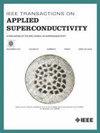Progress of 33 T Cryogen-Free Superconducting Magnet Project at HFLSM
IF 1.7
3区 物理与天体物理
Q3 ENGINEERING, ELECTRICAL & ELECTRONIC
引用次数: 0
Abstract
A 33 T cryogen-free superconducting magnet (33 T-CSM) project is now in progress at HFLSM, IMR, Tohoku University. The 33 T-CSM consists of a φ 68 mm–19 T REBCO (HTS) insert and a φ 320 mm-14 T CuNb/Nb3Sn and NbTi Rutherford (LTS) magnets. The 33 T-CSM system has been installed and tested without the HTS insert in March 2024. The LTS outsert magnet consists of three CuNb/Nb3Sn Rutherford cable coils and two NbTi Rutherford cable coils with an epoxy impregnation. It can generate 14 T in a 320 mm bore with 879 A. This winding makes use of advanced high strength CuNb/ Nb3Sn strands specifically developed for the 33 T-CSM project, enabling high stress design with about 275 MPa in the Nb3Sn coil at 14 T. The 19 T-HTS insert is designed based on the robust REBCO coil technology we proposed in previous works. For the cooling system, a 9 W GM/JT cryocooler is used for the LTS coils, four 4 K-GM cryocoolers cool the REBCO coils (1.5 W each at 4.2 K) and two single-stage cryocoolers are used for the radiation shield and current leads. Helium circulation with compressors ensure the thermal connection between the coils and the cryocoolers. The initial cooling is about 7.3 days from room temperature. The test of the 14 T LTS magnet was successfully completed up to 839 A with the nominal maximum electromagnetic stress of 275 MPa after one training quench.求助全文
约1分钟内获得全文
求助全文
来源期刊

IEEE Transactions on Applied Superconductivity
工程技术-工程:电子与电气
CiteScore
3.50
自引率
33.30%
发文量
650
审稿时长
2.3 months
期刊介绍:
IEEE Transactions on Applied Superconductivity (TAS) contains articles on the applications of superconductivity and other relevant technology. Electronic applications include analog and digital circuits employing thin films and active devices such as Josephson junctions. Large scale applications include magnets for power applications such as motors and generators, for magnetic resonance, for accelerators, and cable applications such as power transmission.
 求助内容:
求助内容: 应助结果提醒方式:
应助结果提醒方式:


